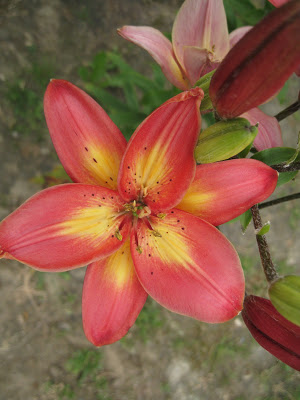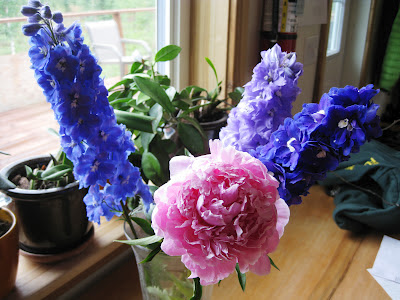A Lesson Plan for Gardening in Classrooms in Alaska, by Cheryl Illg, an Alaskan Master Gardener
Subject Area: Writing/Reading/Science
Appropriate Grade Level: Grade 2
Ideal season for lesson: Spring
Time to complete lesson: 2-3 hours, in four activities that can be divided over several days, if desired.
 |
| An Asiatic Lily. Photo by Heidi Rader. |
Materials Required:
From Seed to Plant (Rookie Read About Science) by Allan Fowler
From Seed to Plant by Gail Gibbons
The Tiny Seed by Eric Carle
Construction paper
scissors
pencils
yarn
glue
lily or other live flower to demonstrate the parts of the plant
lined writing paper or copy attached work sheets.
Goal and Outcomes
Make a large flower out of construction paper. Identify and label plant parts, write brief descriptions of each part’s function/job including: roots, stem, leaves, sepal, flower petal, stamen, and pistil.
A Step-by-Step guide to teaching your lesson:
Activity 1
Gather students together seated on the floor. Ask students to describe what a plant is? What are some examples from the playground, at home or in the produce section of the market? Then read the following books: From Seed to Plant (Rookie Read About Science) by Allan Fowler, From Seed to Plant by Gail Gibbons, The Tiny Seed by Eric Carle. While reading ask students to answer the following questions as they are addressed in the text:
What do plants need to grow? sun, warmth, water, soil, with nutrients, air
Where do plants start to grow? On or in the soil from a seed
What grows first? Seed, leaves and stem
Next? True leaves, more stem, buds, flowers etc.
What does each plant part do?
Activity 2
Demonstrate how to make a plant/flower with construction paper and supplies listed above. Allow students time to make (cut, glue and label) each part as you demonstrate step-by-step.
From large, green sheets of construction paper, cut a large strip of paper 2×24 inches long for the stem. Hole punch 2-3 holes along the bottom edge. Label stem.
Cut 6 in. lengths of orange or brown yarn and tie through the holes at the bottom of stem (or glue if preferred). Label roots.
Cut out 2 heart shaped green leaves and label seed leaf, and glue 6 in. above the roots.
Trace 2 hands on green paper with fingers close together, cut out, label true leaves, and glue 6 in. above seed leaves
Cut out 4 green isosceles triangles, glue near the top of stem with longest point toward the roots, label sepal
Choose bright flower colored construction paper to trace 4 hands with fingers spread apart. Cut out and glue at the top of stem above sepal in a circular fashion with palms over lapping and fingers pointing out to look like a flower and label petals on the fingers.
Cut out 2 brown rectangles ½ in by 3 in, cut out 2 yellow ovals, glue on top end of rectangles and label stamen
Last, cut out 1 orange rectangle ½ in by 4 inches and label it pistil. Glue stamen and pistil in the center of the palms or flowers.
Note much of this can be prepared ahead of time to save time cutting. Labels could also be done once all the parts are together instead of step by step.
Activity 3
 |
| A bouquet of delphiniums and peonies. Photo by Heidi Rader. |
From a bouquet of different flowers on your desk, give one flower to each group of children. Ask them to find and give the names of the parts of the plant and flower. Trade flowers. Some will have more obvious and less obvious parts. The comparison is important. Not all flowers look the same, but they all have similarities.
Activity 4
Ask students to write 3 new things they learned about plants and write a brief description of what each plant parts does. See attached work sheets. Remind students to write complete sentences with a capital letter at the beginning of each sentence and punctuation at the end. Examples of possible sentence starters:
I learned _______.
Plants need______ to______.
Note these examples may be posted for students to get ideas for their own sentences.
Curricular connections/extension activities for other subjects (correlated to GLEs when appropriate)
Grade 2 Reading:
The student comprehends literal or inferred meaning from text by
[2] 1.2.1 Answering questions about information explicitly stated in text.
[2] 1.2.2 Self-monitoring comprehension by making predictions or formulating questions while reading (e.g., why is the wolf dressed in grandmother’s clothing, why are mother bears dangerous, what will happen next), or rereading (e.g., for clarification, confirmation, correction)
[2] 1.2.3 Making simple inferences
[2] 1.2.4 Drawing conclusions about stories and/or based on information presented in the text (e.g., cause and effect).
Grade 2 Writing
The student writes about a topic by
[2] 1.1.1 Writing complete sentences with a subject and a predicate
[2] 1.1.2 Writing and organizing thoughts into a topic sentence and two supporting sentences
Grade 3 Science
The student develops an understanding of the processes of science by
[3] SA1.1 asking questions, predicting, observing, describing, measuring, classifying, making generalizations, inferring and communicating
[3] SA1.2 observing and describing the student’s own world to answer simple questions
Bibliography
Carle, Eric. The Tiny Seed. New York: Simon & Schuster Children’s Publishing, 1998.
Fowler, Allan. From Seed to Plant Rookie Read About Science. Pennsylvania State University: Children’s Press, 2001.
Gibbons, Gail. From Seed to Plant. New York: Holiday House, 1991.
https://www.kennedy.dubuque.k12.ia.us/3rdgradelinks.html
Welcome to the Plant Kingdom! By Heidi Radar UAF Cooperative Extension Services Tanana Chief Conference Presentation in Lesson One the of the Alaska Master Gardener course has some detailed diagrams and descriptions of plant parts useful to this lesson.
What is the job or function of each plant part?
Flower_______________________________________________________________________________________________________________________________________________________________________________________________________________________________
Stamen______________________________________________________________________________________________________________________________________________________________________________________________________________________________
Pistil_________________________________________________________________________________________________________________________________________________________________________________________________________________________________
Sepal_________________________________________________________________________________________________________________________________________________________________________________________________________________________________
Roots_________________________________________________________________________________________________________________________________________________________________________________________________________________________________
What are 3 things you learned about plants?
1.____________________________________________________________________________________________________________________________________________________________________________________________________________________________________
2.____________________________________________________________________________________________________________________________________________________________________________________________________________________________________
3.____________________________________________________________________________________________________________________________________________________________________________________________________________________________________
About Heidi Rader
Twitter •